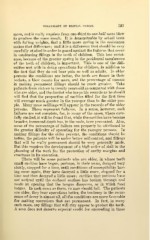Page 335 - My FlipBook
P. 335
TREATMENT OP DENTAL CARIES. 197
more, and it really requires from one-third to one-half more blow-
to produce the same result. It is demonstrable by actual tests
with falling weights, that a little more spring in the resistance
makes that difference ; and it is a difference that should be very
carefully studied in order to guard against the failures that occur
in condensing fillings in the teeth of children. This less resist-
ance, because of the greater spring in the peridental membranes
of the teeth of children, is important. This is one of the diffi-
culties met with in doing operations for children, in addition to
the fact that they do not bear pain so well as adults. In older
persons the conditions are better, the teeth are firmer in their
sockets, a blow counts for more, and the percentage of success
in making permanent fillings should be much greater. Take
patients from sixteen to twenty years old as compared with those
who are older, and the dentist who keeps his records as he should
will find that the proportion of cavities filled for the first time
will average much greater in the younger than in the older peo-
ple. Many more refillings will appear in the records of the older
persons. These represent failures. In a sense, however, such
failures are not complete, for, in many of the cases, where care-
fully studied, it will be found that, while the cavities have become
broader, increased depth has, in the main, been prevented. Also,
some of the percentage of failure can properly be attributed to
the greater difficulty of operating for the younger persons. In
making fillings for the older persons, the conditions should be
better, the patients will be under better self-control, and fillings
that will be really permanent should be very generally made.
But this requires the development of a high order of skill in the
planning of the work for the protection of cavity margins and
exactness in its execution.
There will be some patients who are older, in whose teeth
small cavities have begun, perhaps, in their teens, decayed very
slowly, stopped for a time, until conditions of susceptibility hav-
ing come again, they have decayed a little more, stopped for a
time and then decayed a little more ; cavities that patients have
not noticed until the occlusal surface has broken through and
made an opening that the tongue discovers, or in which food
lodges. In such cases as these, no man should fail. The patients
are older, they bear operations better, the tendency to the recur-
rence of decay is almost nil, all the conditions are more favorable
for making operations that are permanent. In fact, in many
such cases, any fillings that will stay appear to protect the teeth.
A man does not deserve especial credit for succeeding in these


